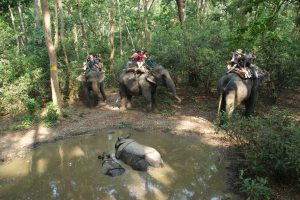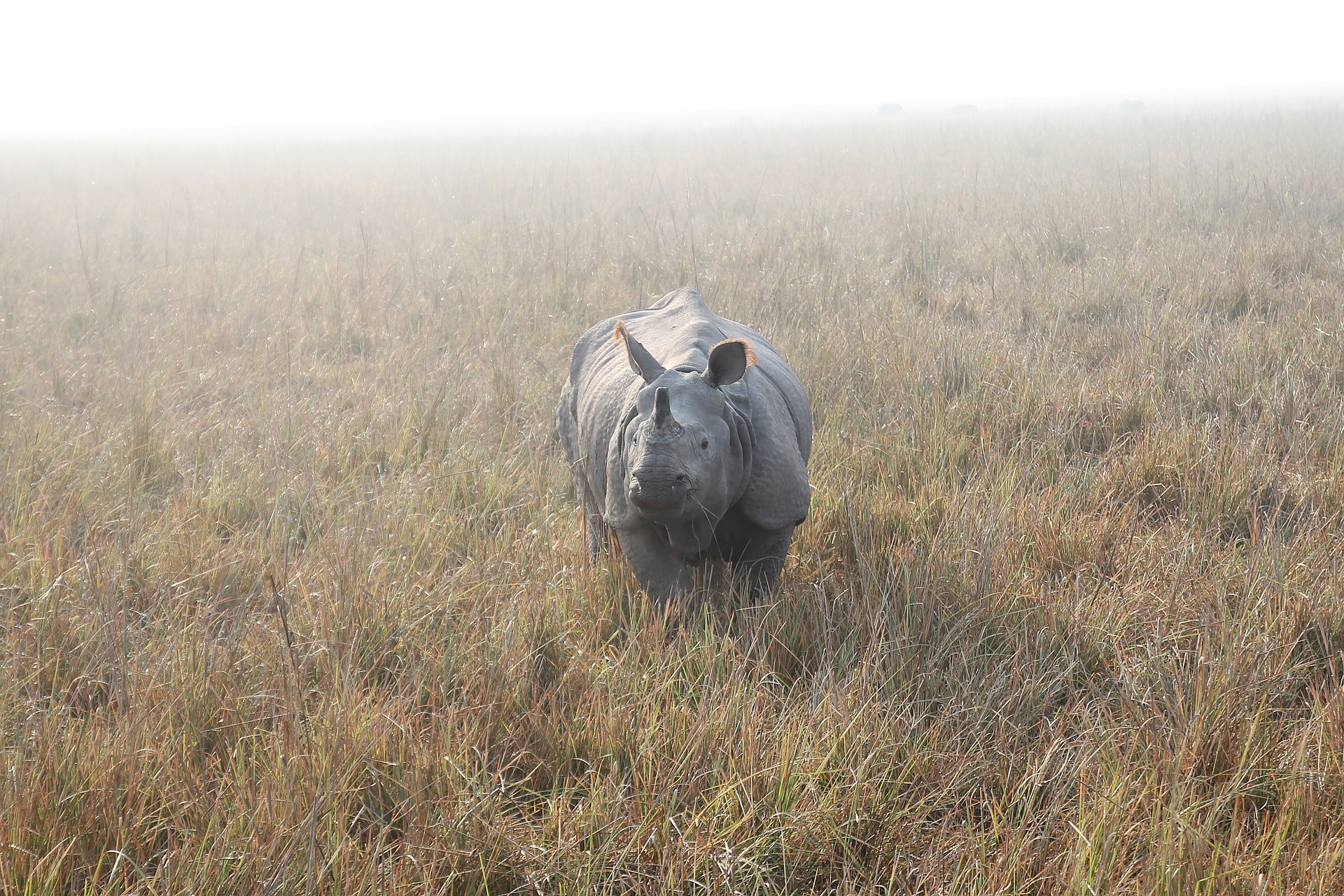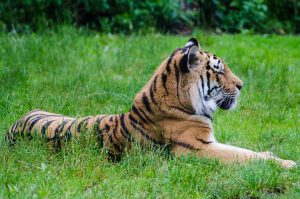 The Chitwan National Park is UNESCO World Heritage site lies in the subtropical southern part of Nepal at the bottom of Mahabharat Parbat range. It covers 932 sq kilometres.
The Chitwan National Park is UNESCO World Heritage site lies in the subtropical southern part of Nepal at the bottom of Mahabharat Parbat range. It covers 932 sq kilometres.
It is popular for many flora and fauna. Chitawan National Park’s official website says that there are 68 species of mammals, 544 species of birds, 56 species of herpeto fauna and 126 species fish have been recorded in the park.
The park is popular for Royal Bengal Tigers, One Horned Rhinos, Ghadiyal (Ghariyal) and Mugger (Marsh) crocodiles, Elephants, Peacocks.
There are lots of resorts, lodges and hotels available to stay and food to suite any nationalities.
Things you can do in Chitawan National Park
This UNESCO World Heritage site Chitawan National Park is one of the best national parks in the world. You can do a jungle walk or elephant safari, canoeing, bird watching, visit elephant breeding centre, crocodile breeding centre, visit Tharu village, watch Bengal tigers or one horned rhinos.
Jungle Safari – 4WD, elephant ride, Jungle walk
4WD ride is popular among people who do not like to ride on elephant or do not want jungle walk. It’s about 3 hour tour where they take you to deep jungle. If you are lucky, you will be able to see rhinos, Bengal tigers, deers, wild boars and will certainly see many Mugger crocodiles taking sunbathe on river sides along with many types of birds as well as monkeys. Negative side of 4WD tour is that you can only go on the roads. Positive aspect is that you can cover a long distance as opposed to Elephant ride or jungle walk.
 Elephant Safari is also considered a safe option. Normally few elephants go together. You can have a better view of animals. Each elephant carry 5 persons including Mahout. Mahouts are expert riders and they will take you as close as possible to rhinos. Elephant safari is specially used for sightseeing of rhinos.
Elephant Safari is also considered a safe option. Normally few elephants go together. You can have a better view of animals. Each elephant carry 5 persons including Mahout. Mahouts are expert riders and they will take you as close as possible to rhinos. Elephant safari is specially used for sightseeing of rhinos.
Jungle walk can be done with guides. You have to be very much vigilant about the surrounds. You encounter one horned rhinos, Bengal tigers or bears. There could be snakes wondering around too so it’s always best to walk with a larger group. Solo jungle walk is a big NO although you’re with a guide.
Crocodile and elephant breeding centre
Crocodile breeding centres is at Kasara in Royal Chitawan National Park. Crocodile breeding centre is funded by WWF and has been successful in breeding Gharials (Ghadials) and releasing them in wild. Ghariyals are endangered species. They survive eating fish.
You can see crocodile eggs, baby crocodiles to large ready to release crocodiles at the crocodile breeding centre.
Elephant breeding centre is located at Sauraha in Chitawan National Park. It was established in 1985 with 6 male and 14 female elephants. You can see them taking bathe, baby elephants playing with mums and other adults.
Canoeing and Bird watching
Bird watching and canoeing are done together. It’s best to do canoeing early in the morning as it is considered the best time to watch birds. You can see many different types of birds and mostly in a group. 600 types of birds are found in Royal Chitawan National Park including migrant birds. The canoeing is done in Rapti river.
Tharu dance
Tharu is ethnic group of Nepal. They live in southern foothills. They love and maintain their traditions. Tharu dance is popular among Chitawan National Park visitors. The main attractions are Peacock dance and Stick dance. Some hotels and resorts have their own dance team who perform during dinner time. You can watch Tharu dance in a hall with a paid ticket which runs every evening.
Permits
No special permits required. There’s a fee to enter the park. Children under 10 are free to enter the park but must be accompanied by an adult.
Laws and Regulations
You have to abide by local laws and regulations. There are certain regulations which you can find in Chitawan National Park Official site.
Accommodation
There are many different types of accommodation available to suit any budget.
Costs
US$300 – US$2,000 depending upon number of days, season, type of accommodation/agent and activities you choose.
The entry fees per person for each entry while writing this is
NRS 1,000 – for visitors from SAARC countries
NRS 2,000 – for visitors from other countries
Free – Children under 10 years
Visit Nepal Government official site for park entry fees.
Climate
Chitawan is humid throughout the year. It can be categorised as 3 main seasons – summer, winter and monsoon. Mid-October to Mid-February is winter. The average daytime temperature is 22 Degree Celsius to 28 Degree Celsius during this time with maximum temperature in December is about 18-22 Degree Celsius and minimum can be about 5 Degree Celsius.
Heavy rain falls expected during Monsoon period so it’s difficult to travel around in June and July.
Temperatures can go up to low 40s few days.
What to wear
Dress for comfort. Warm or summer clothes depending upon your travel season.
Transport
Local: Public bus, hired cars (normally comes with driver), normally tour operators organise their vehicles from Chitawan Bus Park or from Kathmandu
From Kathmandu and Pokhara: Air Plane, Public Bus, Tourist Bus, hired Car, tour organiser’s vehicles
Distance
Kathmandu to Chitawan is about 175 kilometres from Kathmandu.
Travel Time
Driving distance is about 5 hours from Kathmandu.
Dining
You can get almost any food in Chitawan to suit any taste. There are quality restaurants and plenty of liquor choices. There are lots of resorts, lodges and hotels available to stay and food to suite any nationalities.




Comments are closed, but trackbacks and pingbacks are open.